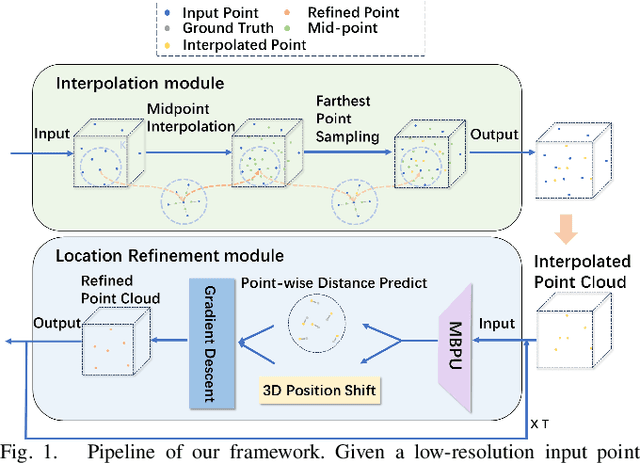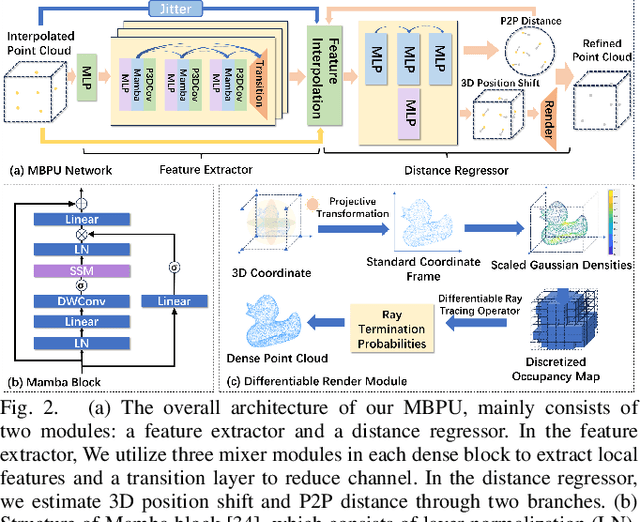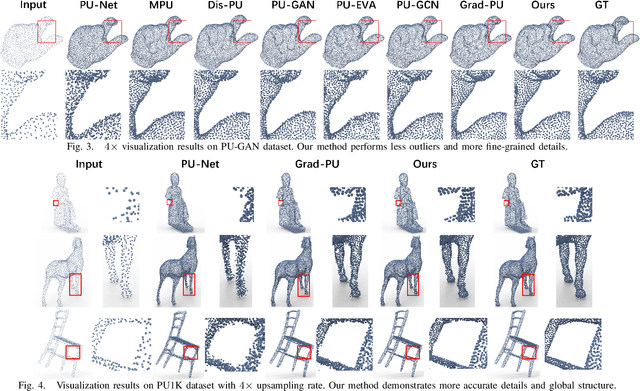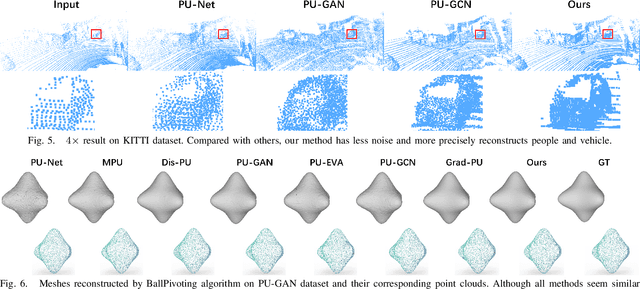Weidong Yang
Gaussian2Scene: 3D Scene Representation Learning via Self-supervised Learning with 3D Gaussian Splatting
Jun 11, 2025Abstract:Self-supervised learning (SSL) for point cloud pre-training has become a cornerstone for many 3D vision tasks, enabling effective learning from large-scale unannotated data. At the scene level, existing SSL methods often incorporate volume rendering into the pre-training framework, using RGB-D images as reconstruction signals to facilitate cross-modal learning. This strategy promotes alignment between 2D and 3D modalities and enables the model to benefit from rich visual cues in the RGB-D inputs. However, these approaches are limited by their reliance on implicit scene representations and high memory demands. Furthermore, since their reconstruction objectives are applied only in 2D space, they often fail to capture underlying 3D geometric structures. To address these challenges, we propose Gaussian2Scene, a novel scene-level SSL framework that leverages the efficiency and explicit nature of 3D Gaussian Splatting (3DGS) for pre-training. The use of 3DGS not only alleviates the computational burden associated with volume rendering but also supports direct 3D scene reconstruction, thereby enhancing the geometric understanding of the backbone network. Our approach follows a progressive two-stage training strategy. In the first stage, a dual-branch masked autoencoder learns both 2D and 3D scene representations. In the second stage, we initialize training with reconstructed point clouds and further supervise learning using the geometric locations of Gaussian primitives and rendered RGB images. This process reinforces both geometric and cross-modal learning. We demonstrate the effectiveness of Gaussian2Scene across several downstream 3D object detection tasks, showing consistent improvements over existing pre-training methods.
Seasonal Forecasting of Pan-Arctic Sea Ice with State Space Model
May 15, 2025Abstract:The rapid decline of Arctic sea ice resulting from anthropogenic climate change poses significant risks to indigenous communities, ecosystems, and the global climate system. This situation emphasizes the immediate necessity for precise seasonal sea ice forecasts. While dynamical models perform well for short-term forecasts, they encounter limitations in long-term forecasts and are computationally intensive. Deep learning models, while more computationally efficient, often have difficulty managing seasonal variations and uncertainties when dealing with complex sea ice dynamics. In this research, we introduce IceMamba, a deep learning architecture that integrates sophisticated attention mechanisms within the state space model. Through comparative analysis of 25 renowned forecast models, including dynamical, statistical, and deep learning approaches, our experimental results indicate that IceMamba delivers excellent seasonal forecasting capabilities for Pan-Arctic sea ice concentration. Specifically, IceMamba outperforms all tested models regarding average RMSE and anomaly correlation coefficient (ACC) and ranks second in Integrated Ice Edge Error (IIEE). This innovative approach enhances our ability to foresee and alleviate the effects of sea ice variability, offering essential insights for strategies aimed at climate adaptation.
* This paper is published in npj Climate and Atmospheric Science: https://www.nature.com/articles/s41612-025-01058-0#Sec16 Supplementary information: https://static-content.springer.com/esm/art%3A10.1038%2Fs41612-025-01058-0/MediaObjects/41612_2025_1058_MOESM1_ESM.pdf
MGSR: 2D/3D Mutual-boosted Gaussian Splatting for High-fidelity Surface Reconstruction under Various Light Conditions
Mar 07, 2025Abstract:Novel view synthesis (NVS) and surface reconstruction (SR) are essential tasks in 3D Gaussian Splatting (3D-GS). Despite recent progress, these tasks are often addressed independently, with GS-based rendering methods struggling under diverse light conditions and failing to produce accurate surfaces, while GS-based reconstruction methods frequently compromise rendering quality. This raises a central question: must rendering and reconstruction always involve a trade-off? To address this, we propose MGSR, a 2D/3D Mutual-boosted Gaussian splatting for Surface Reconstruction that enhances both rendering quality and 3D reconstruction accuracy. MGSR introduces two branches--one based on 2D-GS and the other on 3D-GS. The 2D-GS branch excels in surface reconstruction, providing precise geometry information to the 3D-GS branch. Leveraging this geometry, the 3D-GS branch employs a geometry-guided illumination decomposition module that captures reflected and transmitted components, enabling realistic rendering under varied light conditions. Using the transmitted component as supervision, the 2D-GS branch also achieves high-fidelity surface reconstruction. Throughout the optimization process, the 2D-GS and 3D-GS branches undergo alternating optimization, providing mutual supervision. Prior to this, each branch completes an independent warm-up phase, with an early stopping strategy implemented to reduce computational costs. We evaluate MGSR on a diverse set of synthetic and real-world datasets, at both object and scene levels, demonstrating strong performance in rendering and surface reconstruction.
Satellite Observations Guided Diffusion Model for Accurate Meteorological States at Arbitrary Resolution
Feb 09, 2025Abstract:Accurate acquisition of surface meteorological conditions at arbitrary locations holds significant importance for weather forecasting and climate simulation. Due to the fact that meteorological states derived from satellite observations are often provided in the form of low-resolution grid fields, the direct application of spatial interpolation to obtain meteorological states for specific locations often results in significant discrepancies when compared to actual observations. Existing downscaling methods for acquiring meteorological state information at higher resolutions commonly overlook the correlation with satellite observations. To bridge the gap, we propose Satellite-observations Guided Diffusion Model (SGD), a conditional diffusion model pre-trained on ERA5 reanalysis data with satellite observations (GridSat) as conditions, which is employed for sampling downscaled meteorological states through a zero-shot guided sampling strategy and patch-based methods. During the training process, we propose to fuse the information from GridSat satellite observations into ERA5 maps via the attention mechanism, enabling SGD to generate atmospheric states that align more accurately with actual conditions. In the sampling, we employed optimizable convolutional kernels to simulate the upscale process, thereby generating high-resolution ERA5 maps using low-resolution ERA5 maps as well as observations from weather stations as guidance. Moreover, our devised patch-based method promotes SGD to generate meteorological states at arbitrary resolutions. Experiments demonstrate SGD fulfills accurate meteorological states downscaling to 6.25km.
AdaptiveLog: An Adaptive Log Analysis Framework with the Collaboration of Large and Small Language Model
Jan 19, 2025Abstract:Automated log analysis is crucial to ensure high availability and reliability of complex systems. The advent of LLMs in NLP has ushered in a new era of language model-driven automated log analysis, garnering significant interest. Within this field, two primary paradigms based on language models for log analysis have become prominent. Small Language Models (SLMs) follow the pre-train and fine-tune paradigm, focusing on the specific log analysis task through fine-tuning on supervised datasets. On the other hand, LLMs following the in-context learning paradigm, analyze logs by providing a few examples in prompt contexts without updating parameters. Despite their respective strengths, we notice that SLMs are more cost-effective but less powerful, whereas LLMs with large parameters are highly powerful but expensive and inefficient. To trade-off between the performance and inference costs of both models in automated log analysis, this paper introduces an adaptive log analysis framework known as AdaptiveLog, which effectively reduces the costs associated with LLM while ensuring superior results. This framework collaborates an LLM and a small language model, strategically allocating the LLM to tackle complex logs while delegating simpler logs to the SLM. Specifically, to efficiently query the LLM, we propose an adaptive selection strategy based on the uncertainty estimation of the SLM, where the LLM is invoked only when the SLM is uncertain. In addition, to enhance the reasoning ability of the LLM in log analysis tasks, we propose a novel prompt strategy by retrieving similar error-prone cases as the reference, enabling the model to leverage past error experiences and learn solutions from these cases. Extensive experiments demonstrate that AdaptiveLog achieves state-of-the-art results across different tasks, elevating the overall accuracy of log analysis while maintaining cost efficiency.
Adaptive Prototype Replay for Class Incremental Semantic Segmentation
Dec 17, 2024



Abstract:Class incremental semantic segmentation (CISS) aims to segment new classes during continual steps while preventing the forgetting of old knowledge. Existing methods alleviate catastrophic forgetting by replaying distributions of previously learned classes using stored prototypes or features. However, they overlook a critical issue: in CISS, the representation of class knowledge is updated continuously through incremental learning, whereas prototype replay methods maintain fixed prototypes. This mismatch between updated representation and fixed prototypes limits the effectiveness of the prototype replay strategy. To address this issue, we propose the Adaptive prototype replay (Adapter) for CISS in this paper. Adapter comprises an adaptive deviation compen sation (ADC) strategy and an uncertainty-aware constraint (UAC) loss. Specifically, the ADC strategy dynamically updates the stored prototypes based on the estimated representation shift distance to match the updated representation of old class. The UAC loss reduces prediction uncertainty, aggregating discriminative features to aid in generating compact prototypes. Additionally, we introduce a compensation-based prototype similarity discriminative (CPD) loss to ensure adequate differentiation between similar prototypes, thereby enhancing the efficiency of the adaptive prototype replay strategy. Extensive experiments on Pascal VOC and ADE20K datasets demonstrate that Adapter achieves state-of-the-art results and proves effective across various CISS tasks, particularly in challenging multi-step scenarios. The code and model is available at https://github.com/zhu-gl-ux/Adapter.
MBPU: A Plug-and-Play State Space Model for Point Cloud Upsamping with Fast Point Rendering
Oct 21, 2024



Abstract:The task of point cloud upsampling (PCU) is to generate dense and uniform point clouds from sparse input captured by 3D sensors like LiDAR, holding potential applications in real yet is still a challenging task. Existing deep learning-based methods have shown significant achievements in this field. However, they still face limitations in effectively handling long sequences and addressing the issue of shrinkage artifacts around the surface of the point cloud. Inspired by the newly proposed Mamba, in this paper, we introduce a network named MBPU built on top of the Mamba architecture, which performs well in long sequence modeling, especially for large-scale point cloud upsampling, and achieves fast convergence speed. Moreover, MBPU is an arbitrary-scale upsampling framework as the predictor of point distance in the point refinement phase. At the same time, we simultaneously predict the 3D position shift and 1D point-to-point distance as regression quantities to constrain the global features while ensuring the accuracy of local details. We also introduce a fast differentiable renderer to further enhance the fidelity of the upsampled point cloud and reduce artifacts. It is noted that, by the merits of our fast point rendering, MBPU yields high-quality upsampled point clouds by effectively eliminating surface noise. Extensive experiments have demonstrated that our MBPU outperforms other off-the-shelf methods in terms of point cloud upsampling, especially for large-scale point clouds.
SIFM: A Foundation Model for Multi-granularity Arctic Sea Ice Forecasting
Oct 16, 2024



Abstract:Arctic sea ice performs a vital role in global climate and has paramount impacts on both polar ecosystems and coastal communities. In the last few years, multiple deep learning based pan-Arctic sea ice concentration (SIC) forecasting methods have emerged and showcased superior performance over physics-based dynamical models. However, previous methods forecast SIC at a fixed temporal granularity, e.g. sub-seasonal or seasonal, thus only leveraging inter-granularity information and overlooking the plentiful inter-granularity correlations. SIC at various temporal granularities exhibits cumulative effects and are naturally consistent, with short-term fluctuations potentially impacting long-term trends and long-term trends provides effective hints for facilitating short-term forecasts in Arctic sea ice. Therefore, in this study, we propose to cultivate temporal multi-granularity that naturally derived from Arctic sea ice reanalysis data and provide a unified perspective for modeling SIC via our Sea Ice Foundation Model. SIFM is delicately designed to leverage both intra-granularity and inter-granularity information for capturing granularity-consistent representations that promote forecasting skills. Our extensive experiments show that SIFM outperforms off-the-shelf deep learning models for their specific temporal granularity.
IceDiff: High Resolution and High-Quality Sea Ice Forecasting with Generative Diffusion Prior
Oct 10, 2024Abstract:Variation of Arctic sea ice has significant impacts on polar ecosystems, transporting routes, coastal communities, and global climate. Tracing the change of sea ice at a finer scale is paramount for both operational applications and scientific studies. Recent pan-Arctic sea ice forecasting methods that leverage advances in artificial intelligence has made promising progress over numerical models. However, forecasting sea ice at higher resolutions is still under-explored. To bridge the gap, we propose a two-staged deep learning framework, IceDiff, to forecast sea ice concentration at finer scales. IceDiff first leverages an independently trained vision transformer to generate coarse yet superior forecasting over previous methods at a regular 25km x 25km grid. This high-quality sea ice forecasting can be utilized as reliable guidance for the next stage. Subsequently, an unconditional diffusion model pre-trained on sea ice concentration maps is utilized for sampling down-scaled sea ice forecasting via a zero-shot guided sampling strategy and a patch-based method. For the first time, IceDiff demonstrates sea ice forecasting with the 6.25km x 6.25km resolution. IceDiff extends the boundary of existing sea ice forecasting models and more importantly, its capability to generate high-resolution sea ice concentration data is vital for pragmatic usages and research.
PostCast: Generalizable Postprocessing for Precipitation Nowcasting via Unsupervised Blurriness Modeling
Oct 08, 2024



Abstract:Precipitation nowcasting plays a pivotal role in socioeconomic sectors, especially in severe convective weather warnings. Although notable progress has been achieved by approaches mining the spatiotemporal correlations with deep learning, these methods still suffer severe blurriness as the lead time increases, which hampers accurate predictions for extreme precipitation. To alleviate blurriness, researchers explore generative methods conditioned on blurry predictions. However, the pairs of blurry predictions and corresponding ground truth need to be generated in advance, making the training pipeline cumbersome and limiting the generality of generative models within blur modes that appear in training data. By rethinking the blurriness in precipitation nowcasting as a blur kernel acting on predictions, we propose an unsupervised postprocessing method to eliminate the blurriness without the requirement of training with the pairs of blurry predictions and corresponding ground truth. Specifically, we utilize blurry predictions to guide the generation process of a pre-trained unconditional denoising diffusion probabilistic model (DDPM) to obtain high-fidelity predictions with eliminated blurriness. A zero-shot blur kernel estimation mechanism and an auto-scale denoise guidance strategy are introduced to adapt the unconditional DDPM to any blurriness modes varying from datasets and lead times in precipitation nowcasting. Extensive experiments are conducted on 7 precipitation radar datasets, demonstrating the generality and superiority of our method.
 Add to Chrome
Add to Chrome Add to Firefox
Add to Firefox Add to Edge
Add to Edge